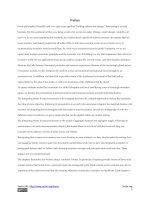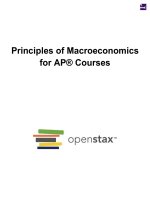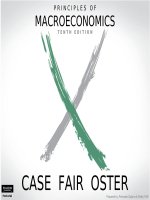Principles of macroeconomics 10e by case fair oster ch09
Bạn đang xem bản rút gọn của tài liệu. Xem và tải ngay bản đầy đủ của tài liệu tại đây (1.07 MB, 66 trang )
PRINCIPLES OF
MACROECONOMICS
PART III The Core of Macroeconomic Theory
TENTH
EDITION
CASE FAIR OSTER
© 2012 Pearson Education, Inc. Publishing as Prentice Hall
Prepared by: Fernando Quijano & Shelly
1 ofTefft
66
PART III The Core of Macroeconomic Theory
© 2012 Pearson Education, Inc. Publishing as Prentice Hall
2 of 66
The Government and
Fiscal Policy
9
CHAPTER OUTLINE
Government in the Economy
Government Purchases (G), Net Taxes (T), and Disposable
Income (Yd)
The Determination of Equilibrium Output (Income)
Fiscal Policy at Work: Multiplier Effects
The Government Spending Multiplier
The Tax Multiplier
The Balanced-Budget Multiplier
PART III The Core of Macroeconomic Theory
The Federal Budget
© 2012 Pearson Education, Inc. Publishing as Prentice Hall
The Budget in 2009
Fiscal Policy Since 1993: The Clinton, Bush, and Obama
Administrations
The Federal Government Debt
The Economy’s Influence on the Government
Budget
Automatic Stabilizers and Destabilizers
Full-Employment Budget
Looking Ahead
Appendix A: Deriving the Fiscal Policy Multipliers
Appendix B: The Case in Which Tax Revenues
Depend on Income
3 of 66
PART III The Core of Macroeconomic Theory
fiscal policy The government’s spending and taxing policies.
monetary policy The behavior of the Federal Reserve
concerning the nation’s money supply.
© 2012 Pearson Education, Inc. Publishing as Prentice Hall
4 of 66
PART III The Core of Macroeconomic Theory
The behavior of the Federal Reserve concerning the nation’s
money supply is called:
a.
Discretionary fiscal policy.
b.
Automatic fiscal policy.
c.
Budgetary policy.
d.
Monetary policy.
© 2012 Pearson Education, Inc. Publishing as Prentice Hall
5 of 66
PART III The Core of Macroeconomic Theory
The behavior of the Federal Reserve concerning the nation’s
money supply is called:
a.
Discretionary fiscal policy.
b.
Automatic fiscal policy.
c.
Budgetary policy.
d.
Monetary policy.
© 2012 Pearson Education, Inc. Publishing as Prentice Hall
6 of 66
Government in the Economy
discretionary fiscal policy Changes in taxes or spending that are the result of
deliberate changes in government policy.
Government Purchases (G), Net Taxes (T), and Disposable Income (Yd)
PART III The Core of Macroeconomic Theory
net taxes (T) Taxes paid by firms and households to the government
minus transfer payments made to households by the government.
disposable, or after-tax, income (Yd) Total income minus net taxes:
Y − T.
disposable income ≡ total income − net taxes
© 2012 Pearson Education, Inc. Publishing as Prentice Hall
Yd ≡ Y − T
7 of 66
PART III The Core of Macroeconomic Theory
Over which of the following categories does the government have
more control?
a.
Tax revenue.
b.
Government expenditures.
c.
Tax rates.
d.
The size of corporate profits.
© 2012 Pearson Education, Inc. Publishing as Prentice Hall
8 of 66
PART III The Core of Macroeconomic Theory
Over which of the following categories does the government have
more control?
a.
Tax revenue.
b.
Government expenditures.
c.
Tax rates.
d.
The size of corporate profits.
© 2012 Pearson Education, Inc. Publishing as Prentice Hall
9 of 66
Government in the Economy
Government Purchases (G), Net Taxes (T), and Disposable Income (Yd)
PART III The Core of Macroeconomic Theory
FIGURE 9.1 Adding Net Taxes
(T) and Government Purchases (G)
to the Circular Flow of Income
© 2012 Pearson Education, Inc. Publishing as Prentice Hall
10 of 66
Government in the Economy
Government Purchases (G), Net Taxes (T), and Disposable Income (Yd)
The disposable income (Yd) of households must end up as either
consumption (C) or saving (S). Thus,
Yd ≡ C + S
PART III The Core of Macroeconomic Theory
Because disposable income is aggregate income (Y) minus net taxes
(T), we can write another identity:
Y − T ≡ C + S
By adding T to both sides:
Y ≡ C + S + T
Planned aggregate expenditure (AE) is the sum of consumption
spending by households (C), planned investment by business firms (I),
and government purchases of goods and services (G).
© 2012 Pearson Education, Inc. Publishing as Prentice Hall
AE ≡ C + I + G
11 of 66
Select the best answer. Households use their disposable income
(Yd) to do the following:
Consume.
Consume and save.
Consume, save, and pay taxes.
Consume, save, pay taxes, and buy imports.
PART III The Core of Macroeconomic Theory
a.
b.
c.
d.
© 2012 Pearson Education, Inc. Publishing as Prentice Hall
12 of 66
Select the best answer. Households use their disposable income
(Yd) to do the following:
Consume.
Consume and save.
Consume, save, and pay taxes.
Consume, save, pay taxes, and buy imports.
PART III The Core of Macroeconomic Theory
a.
b.
c.
d.
© 2012 Pearson Education, Inc. Publishing as Prentice Hall
13 of 66
Government in the Economy
Government Purchases (G), Net Taxes (T), and Disposable Income (Yd)
budget deficit The difference between what a government spends
and what it collects in taxes in a given period: G − T.
PART III The Core of Macroeconomic Theory
budget deficit ≡ G − T
© 2012 Pearson Education, Inc. Publishing as Prentice Hall
14 of 66
Government in the Economy
Government Purchases (G), Net Taxes (T), and Disposable Income (Yd)
Adding Taxes to the Consumption Function
To modify our aggregate consumption function to incorporate
disposable income instead of before-tax income, instead of
C = a + bY, we write
PART III The Core of Macroeconomic Theory
C = a + bYd
or
C = a + b(Y − T)
Our consumption function now has consumption depending
on disposable income instead of before-tax income.
© 2012 Pearson Education, Inc. Publishing as Prentice Hall
15 of 66
PART III The Core of Macroeconomic Theory
When government enters the circular flow of income, which of the
following is an expression for planned aggregate expenditure?
a.
Y−T
b.
C+S+T
c.
C+I+G
d.
G–T
© 2012 Pearson Education, Inc. Publishing as Prentice Hall
16 of 66
PART III The Core of Macroeconomic Theory
When government enters the circular flow of income, which of the
following is an expression for planned aggregate expenditure?
a.
Y−T
b.
C+S+T
c.
C+I+G
d.
G–T
© 2012 Pearson Education, Inc. Publishing as Prentice Hall
17 of 66
Government in the Economy
Government Purchases (G), Net Taxes (T), and Disposable Income (Yd)
Planned Investment
PART III The Core of Macroeconomic Theory
The government can affect investment behavior through its
tax treatment of depreciation and other tax policies.
© 2012 Pearson Education, Inc. Publishing as Prentice Hall
18 of 66
Government in the Economy
The Determination of Equilibrium Output (Income)
Y=C+I+G
TABLE 9.1 Finding Equilibrium for I = 100, G = 100, and T = 100
(1)
(2)
(3)
(4)
(5)
(6)
(7)
(8)
(9)
(10)
PART III The Core of Macroeconomic Theory
Unplanned
Planned
Planned
Disposable
Consumption
Saving
Inventory Adjustment
Output
Net
Investment Government Aggregate
Income
Spending
S
Change
(Income) Taxes
Spending Purchases Expenditure
to DisequiY
≡Y
−
T
C
=
100
+
.75
Y
Y
–
C
Y
−
(C + I + G)
Y
T
I
G
C+I+G
librium
d
d
d
300
100
200
250
− 50
100
100
450
− 150
Output ↑
500
100
400
400
0
100
100
600
− 100
Output ↑
700
100
600
550
50
100
100
750
− 50
Output ↑
900
100
800
700
100
100
100
900
0
1,100
100
1,000
850
150
100
100
1,050
+ 50
Output ↓
1,300
100
1,200
1,000
200
100
100
1,200
+ 100
Output ↓
1,500
100
1,400
1,150
250
100
100
1,350
+ 150
Output ↓
© 2012 Pearson Education, Inc. Publishing as Prentice Hall
Equilibrium
19 of 66
Government in the Economy
The Determination of Equilibrium Output (Income)
FIGURE 9.2 Finding Equilibrium
Output/Income Graphically
PART III The Core of Macroeconomic Theory
Because G and I are both fixed at
100, the aggregate expenditure
function is the new consumption
function displaced upward by I + G
= 200.
Equilibrium occurs at Y = C + I + G
= 900.
© 2012 Pearson Education, Inc. Publishing as Prentice Hall
20 of 66
Government in the Economy
The Determination of Equilibrium Output (Income)
The Saving/Investment Approach to Equilibrium
saving/investment approach to equilibrium:
PART III The Core of Macroeconomic Theory
S+T=I+G
To derive this, we know that in equilibrium, aggregate
output (income) (Y) equals planned aggregate expenditure
(AE). By definition, AE equals C + I + G, and by definition,
Y equals C + S + T.
Therefore, at equilibrium:
C+S+T=C+I+G
Subtracting C from both sides leaves:
© 2012 Pearson Education, Inc. Publishing as Prentice Hall
S+T=I+G
21 of 66
PART III The Core of Macroeconomic Theory
In the circular flow that includes households, firms, and
government, which of the following expressions is the
leakages/injections approach to equilibrium?
a.
Y = C + I + G.
b.
C + S = I + G.
c.
Y = a + bT + I + G.
d.
S + T = I + G.
© 2012 Pearson Education, Inc. Publishing as Prentice Hall
22 of 66
PART III The Core of Macroeconomic Theory
In the circular flow that includes households, firms, and
government, which of the following expressions is the
leakages/injections approach to equilibrium?
a.
Y = C + I + G.
b.
C + S = I + G.
c.
Y = a + bT + I + G.
d.
S + T = I + G.
© 2012 Pearson Education, Inc. Publishing as Prentice Hall
23 of 66
Fiscal Policy at Work: Multiplier Effects
At this point, we are assuming that the government controls G and T. In this
section, we will review three multipliers:
Government spending multiplier
Tax multiplier
PART III The Core of Macroeconomic Theory
Balanced-budget multiplier
© 2012 Pearson Education, Inc. Publishing as Prentice Hall
24 of 66
Fiscal Policy at Work: Multiplier Effects
The Government Spending Multiplier
government spending multiplier =
1
MPS
PART III The Core of Macroeconomic Theory
government spending multiplier The ratio of the change in the
equilibrium level of output to a change in government spending.
© 2012 Pearson Education, Inc. Publishing as Prentice Hall
25 of 66









